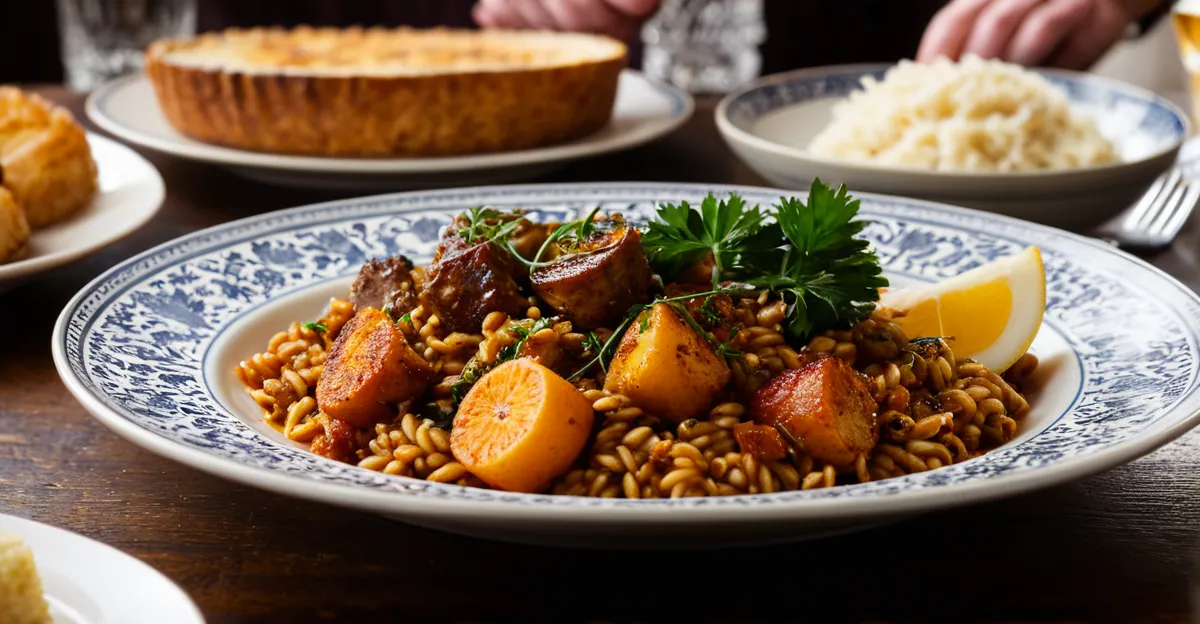Distinctive Ingredients in Traditional UK Dishes
Traditional UK ingredients form the backbone of classic British foods, reflecting a cuisine deeply tied to the land and sea. Root vegetables such as potatoes, carrots, and parsnips are staples, often forming the hearty base of many UK cuisine staples like stews and roasts. Meats, prominently beef, lamb, and pork, also play a vital role in shaping traditional dishes. Additionally, the UK’s extensive coastline provides an abundance of local seafood, including cod, haddock, and shellfish, which are integral to renowned British recipes.
Seasonality and locally sourced produce greatly influence the authenticity and flavor profile of British foods. Using fresh, regional ingredients ensures that traditional UK dishes maintain their characteristic taste and nutritional value. For example, spring lamb and new potatoes feature prominently in seasonal menus, while hardy root vegetables dominate winter cooking.
Additional reading : What are the steps to crafting a classic beef Wellington?
British cheese varieties like Cheddar, Stilton, and Red Leicester contribute significantly to the flavor complexity and texture of many UK dishes. Similarly, the use of fresh herbs such as parsley, thyme, and rosemary—common in British gardens—imbue meals with subtle aromatic notes. Grains like barley, oats, and wheat are foundational to breads, puddings, and breakfast items, further solidifying their importance among traditional UK ingredients. Together, these elements create a diverse yet cohesive culinary identity grounded in regional resources and seasonal availability.
Characteristic Cooking Methods and Techniques
Traditional UK food preparation is defined by British cooking methods that emphasize simplicity and the enhancement of natural flavors. Among these, slow roasting, stewing, and baking are the foundational techniques used across many UK cuisine staples. Slow roasting allows meats like lamb and beef to develop tenderness and depth, while stewing combines root vegetables with meat to yield richly flavored, hearty dishes. Baking is crucial not only for breads and pies but also for layered items like crumbles, showcasing the versatility of heat application in British kitchens.
Have you seen this : What are the tips for making a light and airy spotted dick?
Preservation techniques such as pickling, curing, and smoking have historical importance in British culinary traditions. These methods were originally developed to extend the shelf life of seasonal produce and seafood, supporting sustenance in colder months. Pickling vegetables like cucumbers or onions adds acidity and brightness, contrasting the richness of stewed or roasted foods. Curing meats—most notably bacon—and smoking fish like haddock create distinctive flavors that have become integral to dishes such as kedgeree or traditional breakfasts. These preservation approaches underscore the reliance on locally sourced produce and highlight a resourceful attitude toward ingredients.
Open-fire cooking and one-pot meals remain iconic within the UK’s culinary techniques. Open-fire techniques impart a subtle smokiness to meats and vegetables often found in classic British foods, reflecting a historical link to hearth cooking. One-pot cooking, meanwhile, simplifies preparation while maximizing flavor extraction from ingredients, ideal for stews and casseroles that utilize traditional UK ingredients. This approach not only conserves energy but also caters to social dining, where sharing a warming, wholesome meal is central.
Overall, these British cooking methods and traditional UK food preparation techniques shape the textures and flavors characteristic of the nation’s cuisine. They balance practicality with an appreciation for seasonal, fresh ingredients, reinforcing the identity and enduring popularity of classic British foods.
Signature Flavors and Textures
Traditional UK ingredients create a British flavor palette renowned for its balanced combination of savory, hearty, and subtle notes. UK dish flavors often emphasize natural tastes without overwhelming spices, allowing key components like meats, root vegetables, and cheeses to shine. This restrained seasoning cultivates a comforting and familiar sensory experience that defines classic British foods.
Texture profiles in British cuisine play a crucial role in delivering satisfying meals. A distinguishing feature is the contrast between crispy and soft elements—for example, the golden, crunchy batter of fish and chips complements tender cod beneath. Similarly, fluffy mashed potatoes or soft boiled roots act as mellow counterpoints to robustly cooked meats, enhancing overall enjoyment. This attention to texture ensures that UK cuisine staples evoke both warmth and variety in every bite.
Mild herbs such as parsley, thyme, and rosemary enrich the flavor profiles without overpowering dishes, subtly enhancing natural ingredient qualities. Alongside herbs, rich and comforting sauces—like gravy made from meat drippings—bind flavors and add moisture, deepening taste complexity. These sauces act as a signature element across many traditional UK dishes, reinforcing a homely and hearty eating experience.
In summary, the UK dish flavors and texture profiles British cuisine rely on a delicate interplay between savory depth, textural contrasts, and aromatic simplicity. This distinctive approach results in enduring classic British foods celebrated for their wholesome, approachable character.
Cultural and Historical Influences Shaping UK Dishes
Traditional British meals are deeply intertwined with the history of UK cuisine, reflecting centuries of cultural shifts and external influences. The culinary landscape evolved as a result of historical events like invasions by Romans, Vikings, and Normans, which introduced new ingredients and cooking techniques. These layers of history contributed to the diverse origins of traditional British meals, blending native practices with foreign elements.
The cultural significance of British food is tied to its role in social customs and festivals, where dishes serve as markers of identity and community cohesion. For example, Sunday roasts became ingrained traditions, symbolizing family gatherings and regional pride. Moreover, the age of the British Empire expanded access to spices, preserved foods, and novel commodities that slowly integrated into UK cuisine staples, although classic dishes largely retained a focus on local produce and hearty sustenance.
Over time, the evolution of traditional foods with modern UK society has balanced preservation and innovation. Contemporary chefs revisit classic recipes, adapting them to fit current tastes and dietary preferences while honoring their roots. This dynamic interplay between past and present sustains the relevance of British culinary heritage, ensuring traditional dishes continue to resonate in an ever-changing cultural context.
Notable Regional Diversity Across the UK
The rich tapestry of regional British dishes vividly illustrates the diverse culinary heritage within the UK’s four nations. Each area boasts unique ingredients and recipes that mirror local landscapes and cultural histories, underscoring the distinctness of English, Scottish, Welsh, Irish cuisine, and highlighting the broader UK culinary regions.
In England, the Cornish pasty is a quintessential example, originating from mining communities where a durable, portable meal was essential. Its blend of meat, potato, and root vegetables enclosed in a crust showcases the reliance on traditional UK ingredients reflecting local agricultural produce. Scotland’s famed haggis combines sheep offal with oats and spices, representing resourceful use of available livestock and grains, a signature marker of Scottish culinary identity. Welsh cuisine offers the beloved Welsh rarebit, a cheese-based dish that highlights the importance of dairy farming in Wales, using sharp cheeses like Caerphilly or Red Leicester that are part of the classic British foods spectrum. Northern Ireland’s Ulster fry manifests the hearty breakfast tradition, combining sausages, bacon, eggs, soda bread, and potatoes, all staples across UK cuisine staples.
Regional diversity is also apparent in ingredient sourcing and preparation methods. Coastal regions incorporate abundant seafood, while inland areas rely on robust livestock and hardy vegetables. This results in microcultures within the culinary landscape, where dishes adapt to available resources and cultural preferences. The distinctiveness among regional British dishes not only enriches the UK’s culinary identity but also preserves local histories and traditions, proving essential to the enduring popularity of these classic British foods.








